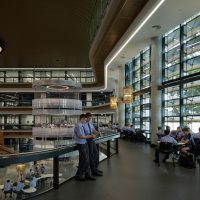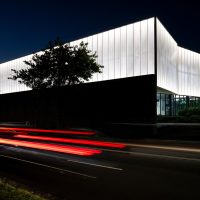Zero Emission Office Building, Coffs Harbour

Architecture That Cuts Energy Costs and Emissions
Engineers, architects and designers are not only reducing costs but eliminating them through eco architecture. Eco friendly architecture is literally powering a commercial office building in Coffs Harbour. With multiple suites and occupants, you’d think the power bill would be high no matter how good the environmental building design. This building is running without energy costs or emissions thanks to sustainable architectural design.
The core idea of this project was to design and construct a small ‘Zero Emission’ office building, to show that such a goal is both attainable and affordable. A year into its occupation, and the building is a resolute success. As intended, electricity consumption is 25 kWH/sqm per annum, well below the average for an office building of the same size; and greenhouse gas emissions were calculated at zero. The north and south façades are made from 65% Danpalon® Multicell 10mm Reflective Grey panels, with the remaining 35% made from fixed and louvred glass panels: a combination that admits enough daylighting for the offices to operate entirely without artificially lighting throughout the day.
Eco Friendly Architecture is Not Expensive
The entire project in Coffs Harbour, including all site fees was $270,000. The office sources little to no energy from the grid and uses no town water thanks to a massive storage tank. The office net import from the grid was 1209 kWH in its first year (sourced from 100% green power). The average office building in NSW is expected to increase to 6.3PJ in 2020. That is equivalent to 1.7+ billion KWH annually. The office will be reducing energy demand to zero with the installation of solar panels.
Australia has seen energy price increases of 117%(1). Queensland, NSW and Victoria have the lowest amount of renewables, the highest energy demands and the highest energy price increases.(2) In Queensland, solar and wind prices increased 3% while electricity increased 136%. As most commercial (and industrial) buildings rely entirely on electricity(3), there is no better time to embrace the natural resources, technology and expertise Australia has on hand.
The National Construction Code was revised in May 2019 to include an energy reduction target of 35%.(4) Architects, designers and engineers are actively updating their preferred products and materials with innovative solutions that respond to this challenge.
References
• Byrd J. Chart of the Day: Something Has Gone Terribly Wrong With Electricity Prices: ABC News; 2018
• Clean Energy Council. Electricity Prices: Clean Energy Council; 2018
• Council of Australian Governments (COAG). Baseline Energy Consumption and Greenhouse Gas Emissions In Commercial Buildings in Australia: Part 1 Report 2012, 25 Jun 2019:[122 p.]
• Master Builders QLD. National Construction Code QLD: Master Builders QLD; 2019
• Australian Government. Energy: Australian Government; 2019
Click to explore more project case study articles or view our project case study videos.


